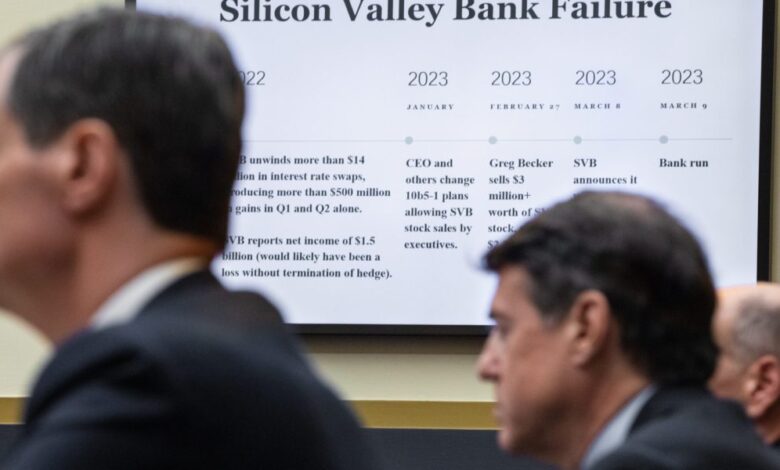Banks are sitting on $500 billion in unrealized losses, and stagflation could cause another Silicon Valley Bank-like crisis


- Banks got caught “chasing yield” and took big losses when the Federal Reserve dramatically hiked interest rates to fight inflation. Those losses are still hanging around, and several experts told Fortune many core issues from the 2023 banking crisis pose a continued threat to the system if economic conditions deteriorate.
Just over two years after the collapse of Silicon Valley Bank and First Republic, banks are still taking big losses thanks to high interest rates. That’s cause for major concern, several experts told Fortune, especially if President Donald Trump’s tariffs lead to the dreaded combination of “stagflation,” or rising inflation coupled with slowing growth, putting further pressure on lenders.
U.S. banks held $482.4 billion in total unrealized losses on securities investments at the end of 2024, according to Federal Deposit Insurance Corporation data, an increase of $118 billion, or 32.5%, from the previous quarter. That number had risen to $515 billion when SVB fell victim to a bank run in March 2023 and peaked at $684 billion later that year. Data for the first quarter of 2025 is expected later this week, but April’s spike in bond yields means any reprieve in the first three months of the year was likely short-lived.
These unrealized losses don’t show up on a bank’s income statement unless the assets are sold, but they represent a looming threat to liquidity if depositors get spooked, said Rebel Cole, a finance professor at Florida Atlantic University who worked for a decade in the Federal Reserve System.
“All it takes is one bad news story about any of these banks, and we could have another banking crisis like we had in March of [2023],” Cole, who has served as a special adviser to the International Monetary Fund and World Bank, told Fortune. “I’m amazed we haven’t had one since then.”
View this interactive chart on Fortune.com
There’s an easy explanation for the chart above: When long-term interest rates spike, the value of assets like similarly long-dated U.S. debt or residential mortgage-backed securities declines.
Bank losses essentially have been fluctuating with the benchmark 10-year Treasury yield, Cole said, which has been on a wild ride in 2025 amid the Trump administration’s chaotic tariff rollout. It currently sits above 4.5%, approaching its high in the fourth quarter.
At that level, the banking system starts “seeing serious problems,” Amit Seru, a finance professor at the Stanford Graduate School of Business, said in an email statement to Fortune.
“It becomes quite bad at 5%,” added Seru, a senior fellow at the university’s Hoover Institution, a conservative-leaning think tank.
Cole said that would equate to roughly $600 billion to $700 billion in unrealized investment losses.
As the chart shows, many of those securities are designated as being “held-to-maturity.” Since they are not intended to be sold, changes in their market value are not reflected directly on the banks’ financial statements and are instead disclosed in balance sheet notes.
However, if lenders are forced to offload some of those investments, Cole said, then the entire portfolio must be marked to market. That means these technically liquid assets become, for the banks’ purposes, exactly the opposite.
“It’s like a rock hanging over the neck of the banks,” Cole said.
Meanwhile, losses on securities deemed “available-for-sale” are recorded on the financial statements, but do not hit earnings unless assets are sold. For Cole, the distinction makes little difference. The rapid demise of SVB, he noted, came after the bank announced it would take a $2 billion loss on the sale of available-for-sale securities.
“Three days later, they were closed,” Cole said.
Next banking crisis just needs ‘one spark’
The failure of the tech industry’s preeminent lender sent shockwaves through the financial system and symbolized the folly of crudely “chasing yield.” When interest rates went to zero during the COVID-19 pandemic, holding a portion of deposits in short-term U.S. Treasury bills provided little return.
In search of a bit more upside, banks looked further down the yield curve, pumping more than $2 trillion into investment securities like long-term U.S. Treasuries (considered “risk-free” assets, if held to full repayment), mortgage-backed securities, and similar assets.
In 2022, the Fed first insisted it would only raise interest rates slightly to address what it deemed to be “transitory” inflation. Instead, price growth surged to four-decade highs, and the central bank was forced to dramatically hike the federal funds rate from roughly 0% in March 2022 to more than 4.5% a year later.
SVB, which had invested more than 90% of its held-to-maturity portfolio in mortgage-backed securities, municipal bonds, and Treasuries with maturities of more than 10 years, became the second-largest bank to fail in U.S. history. Less than two months later, First Republic would overtake SVB on that list.
Despite Fed intervention to make uninsured depositors whole and the acquisitions of both banks, the scars of the crisis and its ripple effects still linger.
SVB’s fragility snuck up on regulators. They’ve since become much more attuned to problems related to interest-rate risk and depositor flight, Seru said. But many of the core issues persist, he added, as capital requirements still largely ignore unrealized losses on securities and loans, while hedging strategies remain limited across much of the banking system.
“So while we may not see another crisis exactly like SVB’s, the ingredients for stress are still present—especially if macroeconomic conditions deteriorate,” Seru wrote.
And as long as interest rates remain high, losses banks accumulated during the crisis are still hanging around.
“In a stagflation scenario, the risk is that rates will be higher for longer and credit losses will begin to accumulate, in particular for lenders to tech, growth, and [venture capital], where borrowers are characterized by having no earnings and low coverage ratios,” Torsten Sløk, chief economist at private equity giant Apollo Global Management, wrote in a note Monday.
Cole, meanwhile, said he sees additional pressure coming from a looming crisis in commercial real estate, leaving banks increasingly vulnerable if investment losses put them under pressure. He said he’s especially worried about regional and super-regional banks with $10 billion to $200 billion in assets, many of which are public companies with major exposure to depositors with holdings above the FDIC’s $250,000 limit for insurance.
“They can’t meet one of those runs if they have any unrealized losses on their securities portfolio,” Cole said. “Then they’ll have to mark that to market, and the regulators will close them.”
In short, banks face a “nightmare scenario” and are sitting on a “tinderbox.”
“And it’s just going to take one spark,” Cole said.
This story was originally featured on Fortune.com
https://fortune.com/img-assets/wp-content/uploads/2025/05/GettyImages-1255509466-e1747240773117.jpg?resize=1200,600
2025-05-14 17:05:16





